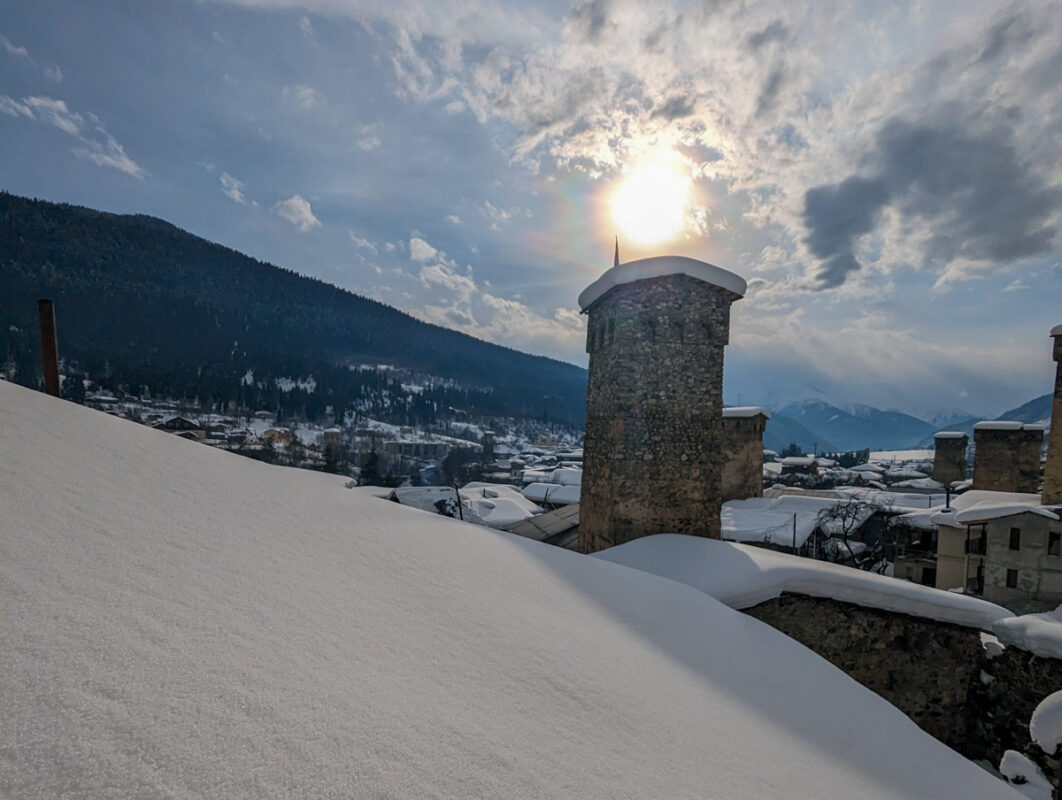Interested in visiting Mestia in winter? Here’s everything you need to know about the largest town in Georgia’s Svaneti region!
The Svan towers, constructed due to village feuds back in the medieval era, stand tall against the milky-coloured mountainous backdrop.
On the streets, a distinct tongue is spoken. It’s not Georgian and certainly not Russian, but it’s Svan, a dialect that is more or less its own language (“I can’t understand it either!”, Kakha, our Tbilsi-based guide told us).
Locals are gearing up for the annual Lamproba festival, which is to be held in the town next weekend.
And on the road, there’s a very distinct possibility of avalanches and six-hour-long hold-ups (as we discovered on our bus journey…)
Mestia in winter is a fascinating, adrenaline-boosting yet sometimes foreboding place.
I recently spent a week in Mestia in February, and here’s everything you need to know!
I visited Mestia as part of a press trip with the Georgian Tourism Board and Traverse Events. All opinions are my own. This blog post may contain affiliate links.
Is Mestia in the winter worth it?
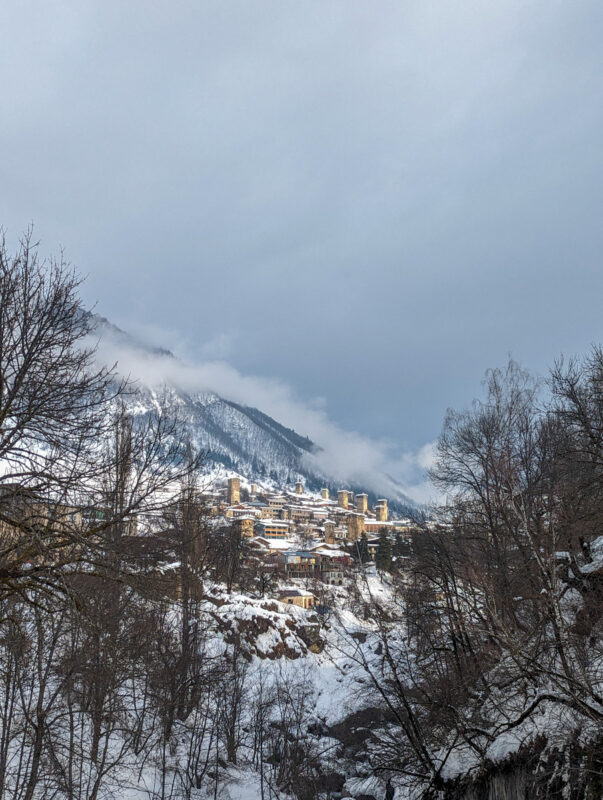
If you’re visiting Mestia in winter, it’s important to be fully aware of what the journey entails.
The winding, mountainous road that leads from Jvari to Mestia is usually open in the winter, but it can close frequently and without warning. (i.e. it can close while you’re on it!).
Possible avalanches and landslides (without avalanche tunnels) mean there is an element of danger on this road in winter and early spring.
There is the option to fly into Mestia, although planes only seem to land when the weather is very clear (we only saw them two out of four of our days in Mestia).
But all that said, Mestia in winter is beautiful, and I loved my four days exploring the town and its vicinity.
But I’d strongly recommend reading through both my experience about reaching the region and my summary of the top things to do before making your own informed decision about whether to visit Mestia in the winter months!
Our experience driving to Mestia in winter

We set off in high spirits, trundling through thickly lined snow-covered roads and surrounded by frozen fir trees.
The sky was darkening, and after pulling the van behind us over a huge icy bump in the road, we rounded the corner to an avalanche (which had just happened). Amazingly, the rest of our convoy, except the two vans behind us, had managed to get through just before the avalanche occurred.
“Snow is very heavy in the winter and avalanches are common”, Wikipedia had warned me when I was researching Svaneti – but I wasn’t aware just how common!
We had to wait for the tractor to overtake our vans and plough away the snow, only to be met by another avalanche when the same happened again.
And again – this time, our driver decided to get out of the car and try to dig it with a shovel. Four other drivers joined them, only for another avalanche to fall – right on them.
Four men escaped, one was stuck under but was fortunately quickly pulled out and was fine, albeit a little chilly.
Then followed an incredibly nerve-wracking 20 minutes sitting in the van without our driver (who had presumably gone to warm up and recover from the shock of nearly being buried in an avalanche), watching mini avalanches happening, terrified that the next one would sweep our van off the road.
Fortunately, the digger once again arrived, cleared the way through the avalanche, and then led the convoy for the next few hundred metres as it dug us out of a few more.
More avalanches had occurred behind us, so the digger drove to the back of the convoy to help those going down the hill (in the end, these people weren’t able to reach the bottom of the mountain and had to sleep in their cars).
Finally, we were away from the avalanche-prone road and made our way straight to Mestia.
This was apparently the worst snow in 20 years – we even made it into the paper – although if you do a quick Google search of “Svaneti avalanches”, you’ll see that they do occur every year.
We felt very lucky that we all escaped unscathed; the snow plough was hit by an avalanche and the driver was hospitalised on that same night.
On the drive back, the road was clear and the weather crisp (we could see where all the avalanches occurred) and we made it to the bottom of the mountain in three hours (the way up was more like seven, which we were honestly glad about as we thought there was a time when we might have to sleep in the car).
So, is driving to Mestia in winter safe? I certainly wouldn’t say my drive up to Mestia was safe, but the drive down felt ok (but even then we did skid on the road at one point when it was very snowy).
Half of our group who escaped the avalanches found the drive up ok, as did some other tourists I spoke to in Mestia.
I do think that we were unlucky with the weather we experienced, but obviously, it’s luck of the draw whether you’re going to encounter this or not.
The drivers, for the most part, are experienced in this type of driving and know where to stop, which areas to not stop in and what to do if an avalanche occurs.
So, the likelihood of your car being hit by one is slim, but it’s possible.
How to get to Mestia by road in winter
So, if you do want to take the road (and weather conditions are looking ok!) here’s how:
You can take the Tbilisi – Zugdidi train (which leaves the capital at 8:30 am and takes around six hours) or hop in a marshrutka to Zugdidi, then change to a van to Mestia.
Transfers to Zugdidi (and occasionally direct to Mestia) are also available from Batumi and Kutaisi.
Wear warm clothes and pack plenty of water and snacks, just in case you have any hold-ups!
Flying to Mestia in winter
The other way to reach Mestia in winter is to fly.
As mentioned, we only saw planes taking off and landing 2/4 days in Mestia, so I presume these may be cancelled or rescheduled at short notice.
But if you want to book a flight, Vanilla Sky offers “airbuses”.
I couldn’t get the website to work when I tried to research ticket costs, but they do have a contact page with phone numbers and a physical office in Tbilisi (44 Kote Abkhazi Street).
What’s Mestia in winter like?
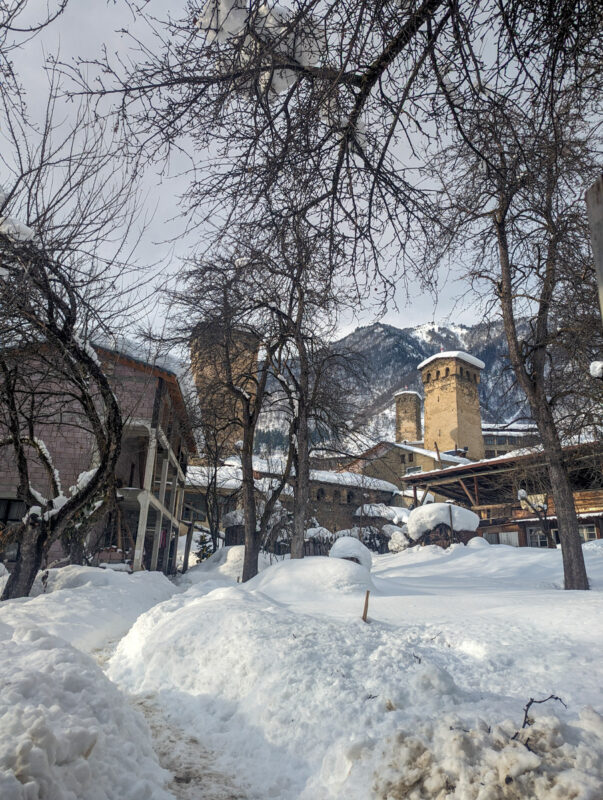
So, you’ve made it to Mestia in the winter. What can you expect once you arrive?
We were greeted with snow that was waist-deep in some parts, each Svan tower looming into the sky with a brilliant white cap.
Life in Mestia doesn’t stop when the snow falls; plenty of people are out and about, and businesses are open as usual.
However, the snowy and icy roads did make walking quite challenging, as evidenced by a member of our group falling and breaking her leg!
What’s the weather like in Mestia in winter?

I was ardently checking the weather forecast for Mestia before we departed – a couple of weeks before our trip, highs sat at a chilly -14°C, so I hastily packed all my thermals and ski gear!
In reality, it had warmed up considerably when we were there and the temperatures hovered around freezing.
There was a lot of snow on the day we travelled up to Mestia and it mostly stuck around for our time there. But on the last day, it was starting to melt as the thermometer crept over 0°C.
So, the weather in Mestia in winter can vary.
You’re almost certain to see some snow, but the actual amount of it depends on the specific year and time of year.
Check out up-to-date forecasts on Accuweather.
Things to do in Mestia in winter
While our journey to Mestia in February was an experience that I wouldn’t rush to repeat, I did very much enjoy my time once I arrived in the town!
Here are the top things to do in Mestia in winter!
1. Budget skiing without the crowds
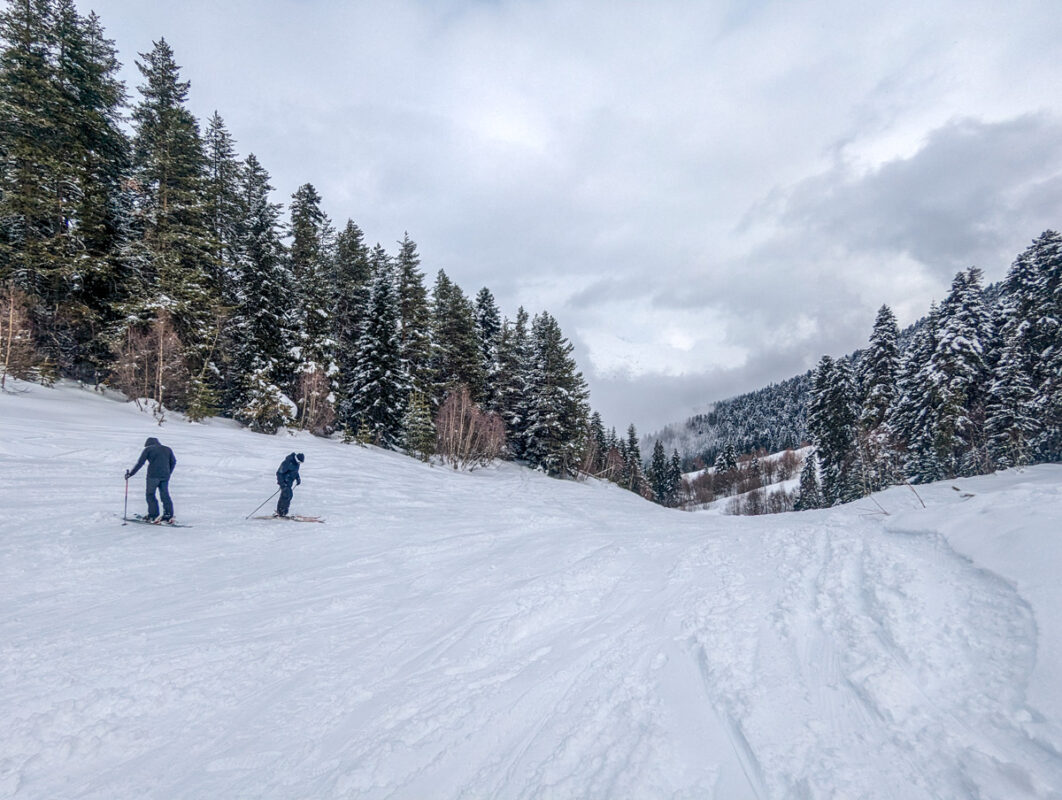
The number one reason, in my opinion, to visit Mestia in the cooler months is to hit the slopes.
The Hatsvali Ski Resort is a stone’s throw from the town – there’s a chair lift departing from the town’s outskirts which connects to a gondola.
It offers a network of mainly red slopes – although there are some easier runs for beginners – ski instructors are also available but should be organised in advance (your hotel will be able to help you with these).
It’s not the most extensive ski resort in Georgia (I’d head to Gudauri if you want a real ski-focused trip), but if you fancy a few days of crowd-free skiing at budget prices, the Mestia resort is a fantastic option.
A one-day ski pass is 50 GEL (€18) and equipment rental in Mestia (I recommend Eidelweiss Ski Rental) is around 40 GEL (€14), with taxis to and from the chair lift being 20 GEL (€7) each way.
It’s around a 20-minute walk from Eidelweiss Ski Rental to the bottom of the chair lift with kit.
So, you can enjoy a day’s skiing in Mestia for less than €40!
2. Papas Qel Banya

For me, there’s nothing better than sinking into a steaming hot tub after a day spent in freezing temperatures.
When that hot tub is surrounded by fir trees and piles of snow? Even better!
Papa’s Qel Banya is a short drive from the top of the chair lift/ bottom of the gondola.
It consists of a hot tub with epic views over evergreen trees and a building with a large sauna, cold plunge pool and relaxation area.
In the snow, the sauna cabin looked straight out of a fairytale!
You can book Papa’s Qel Banya by contacting them on their website or through Instagram.
3. Climb a Svan Tower
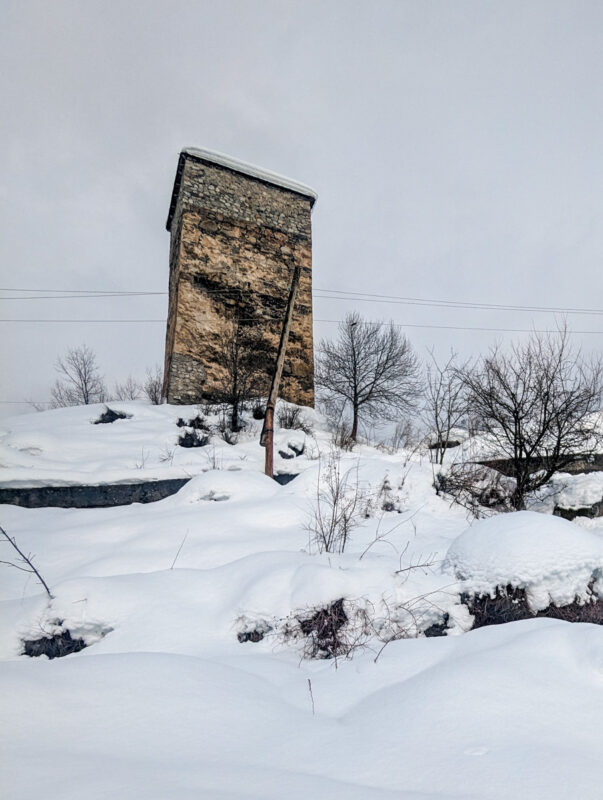
Winter sports aside, one of the top reasons to visit Mestia is to learn about its Svan history and culture.
One of the most interesting things about the Svaneti region is that there used to be lots of village feuds.
So, people lived in tall towers – now called Svan towers – to keep a lookout for people from other villagers who might be coming into their village and starting a war!
Nowadays, the Svan towers are protected buildings and some are open as museums. Many are privately owned, and houses have been built alongside them, but the owners welcome tourists to climb their tower and have a look around for a small fee!
We visited the Niguriani Tower Museum.
On the ground floor, there was an interesting mix of taxidermied animals and farm equipment, and then a network of ladders ascended through the floors (many of which are now used for storage) to the top.
We stopped halfway (the ladders were a little hair-raising!) but still took in a magnificent view from one of the windows.
There are signs outside the Niguriani Tower Museum stating it’s open until 11 pm and we paid the man who showed us around 5 GEL each to ascend the tower (cash only).
Margiani’s House Museum, which sits on a hill above the city, is also visitable, although we didn’t make it to this one (more on that below!).
4. Walk around the city centre
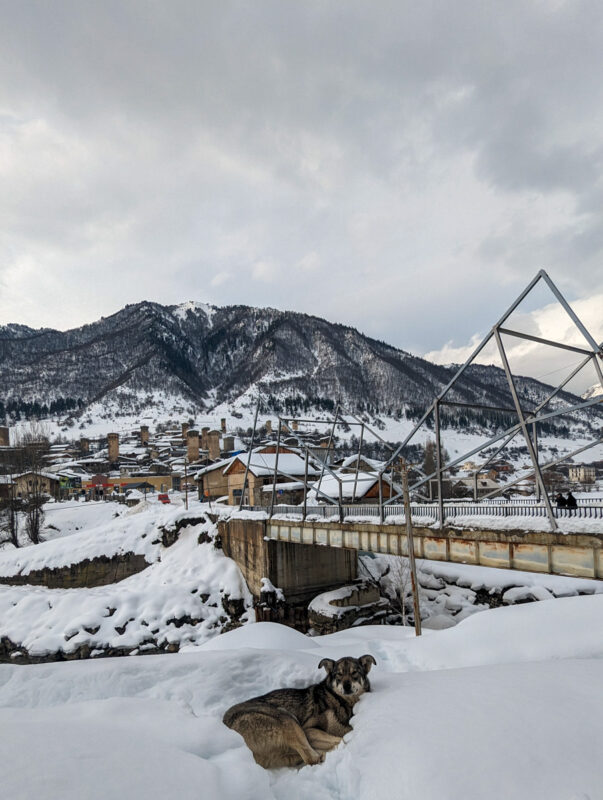
Surrounded by mountains, Mestia has a postcard-perfect city centre and one of my favourite things to do in the town was just to amble around and snap some photos of the churches, peaks and the river.
One note of caution when exploring the centre – there are many cows and dogs. The dogs all seemed very friendly, although if you’re nervous about dogs some of them are a little over-friendly at times!
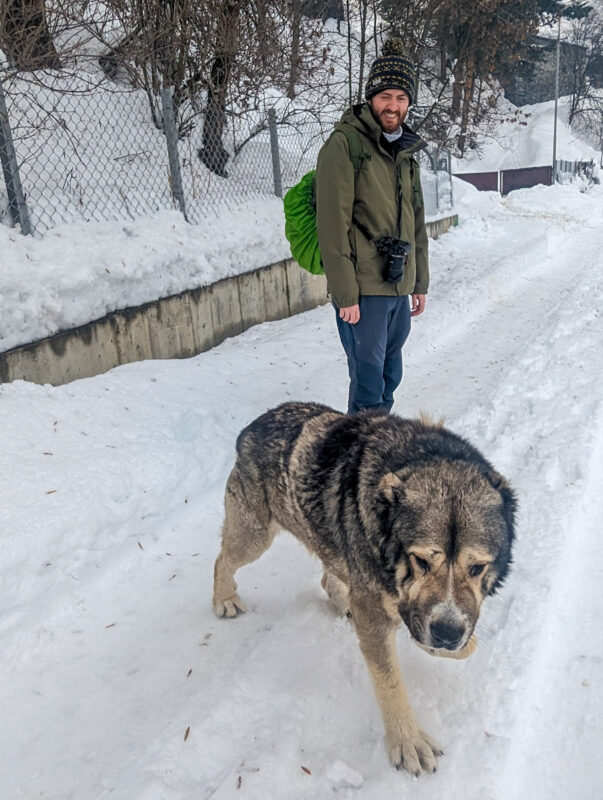
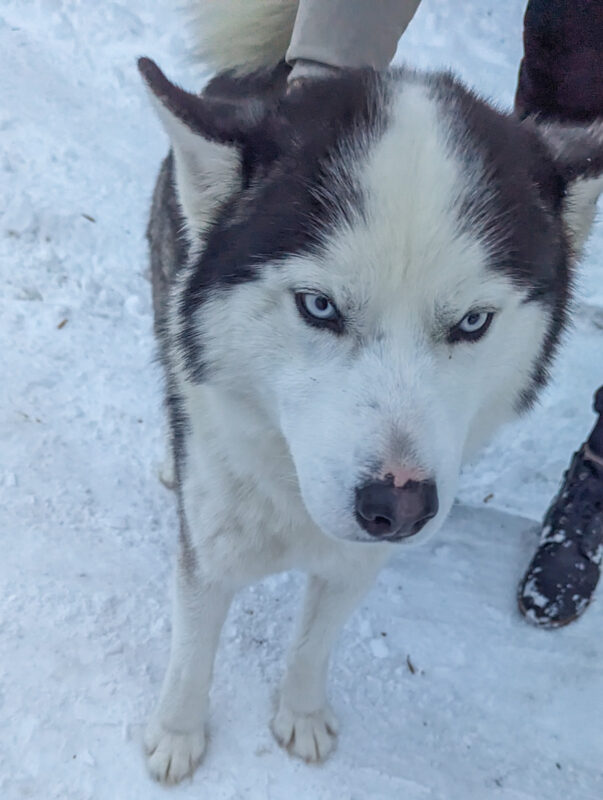
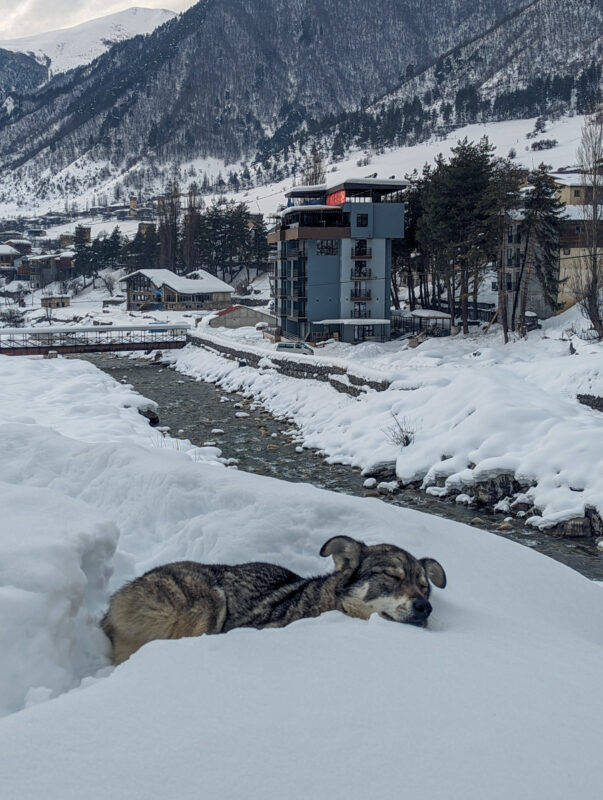
The cows generally minded their own business, unless you try to go past them and they don’t want you to!
I was lightly headbutted in the arm by a cow when trying to walk past one to get to the Margiani’s House Museum.
Unfortunatley, that was the only road to the tower so I was unable to go and see it!
5. Svaneti Museum of History and Ethnography
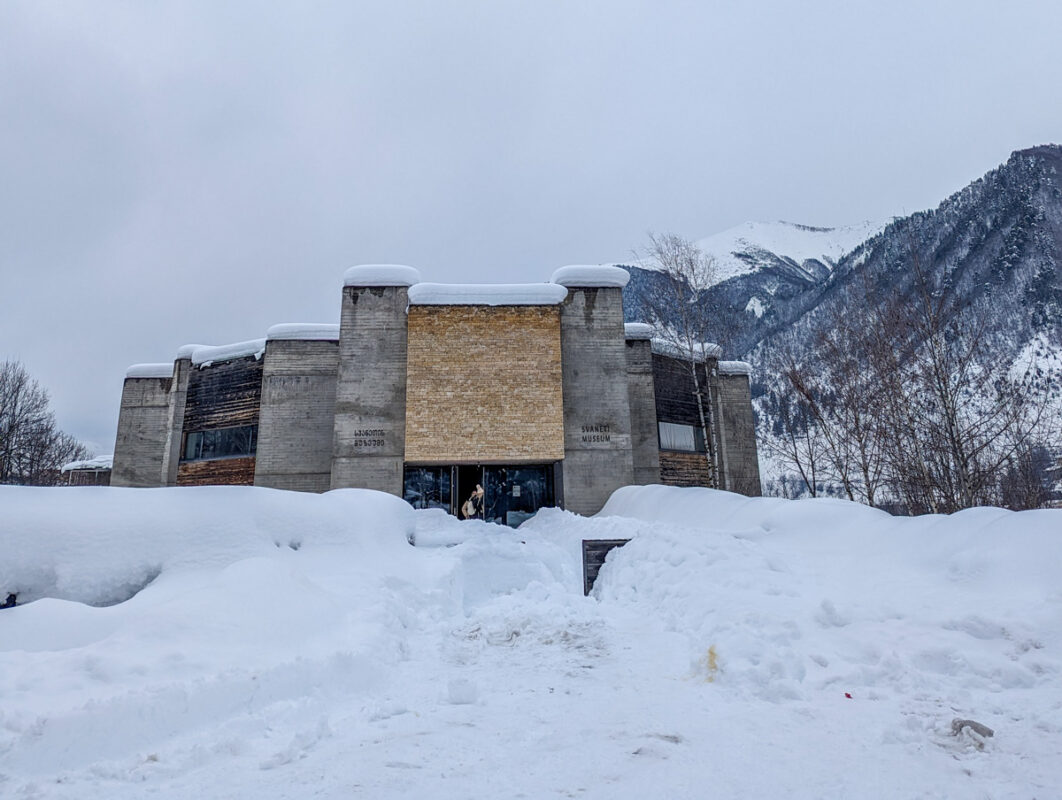
Discover Svaneti culture and history at the iconic Svaneti Museum of History and Ethnography!
This museum – which is very extensive for a small town – details all you need to know about ancient archelogy in Svaneti, proof of its trading with places as far-flung as Syria and Egypt and the first influences of Christianity here.
You’ll learn about how not only did Svaneti’s unique culture develop but also how it was impacted by surrounding areas.
Georgia Travel calls the Svaneti Museum of History and Ethnography “one of the largest treasuries of Georgian history” and here you can get a real sense of Svaneti’s richness as a Georgian region.
6. Culinary masterclass at Lali’s Guesthouse
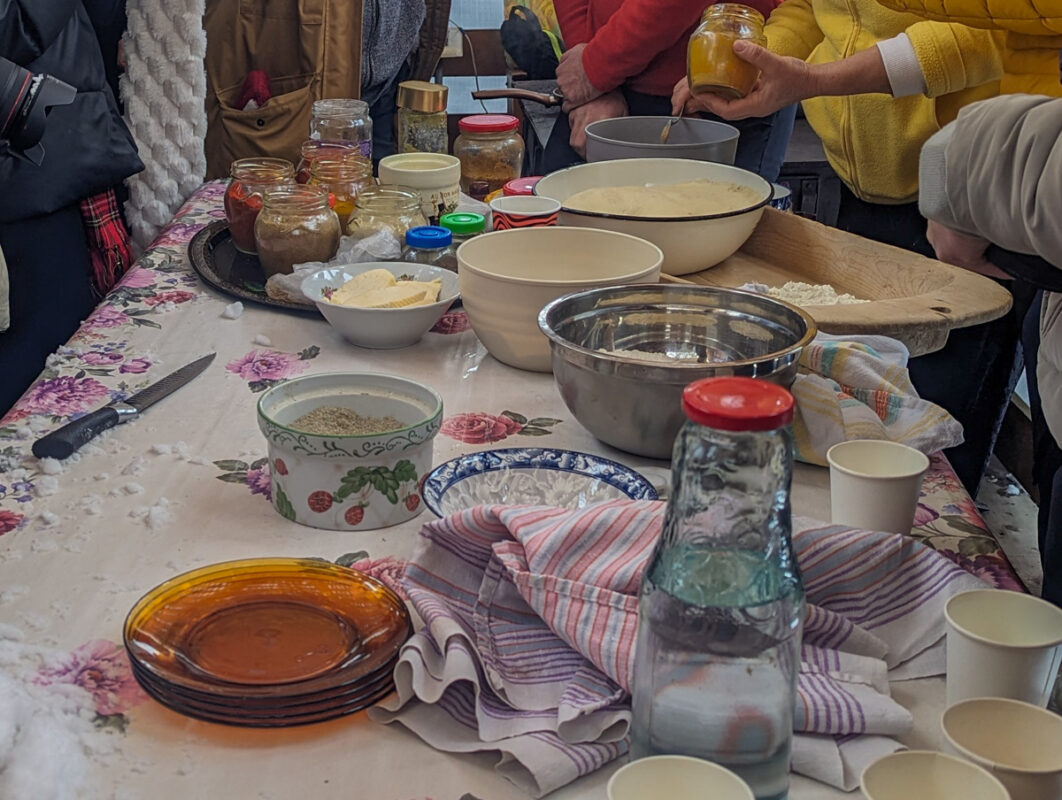
A short drive from Mestia is the village of Latali where, at Lali’s Guesthouse, Lali Nikoloziani offers culinary masterclasses.
Here, you’ll learn to make different types of Svanetian cuisine – while some of these dishes are similar to meals you’ll find elsewhere in Georgia, others have striking differences.
Reach out online for more information about these masterclasses and the food that they serve at the restaurant.
7. Felt hat-making workshop
Some of our group went to a felt hat-making workshop at Maia’s Guesthouse in the nearby Chvabiani village.
At this traditional guesthouse, you can dive deep into Svan culture through this three-day felt hat-making workshop. There’s also plenty of local food, music and culture!
8. Day trip to Ushguili
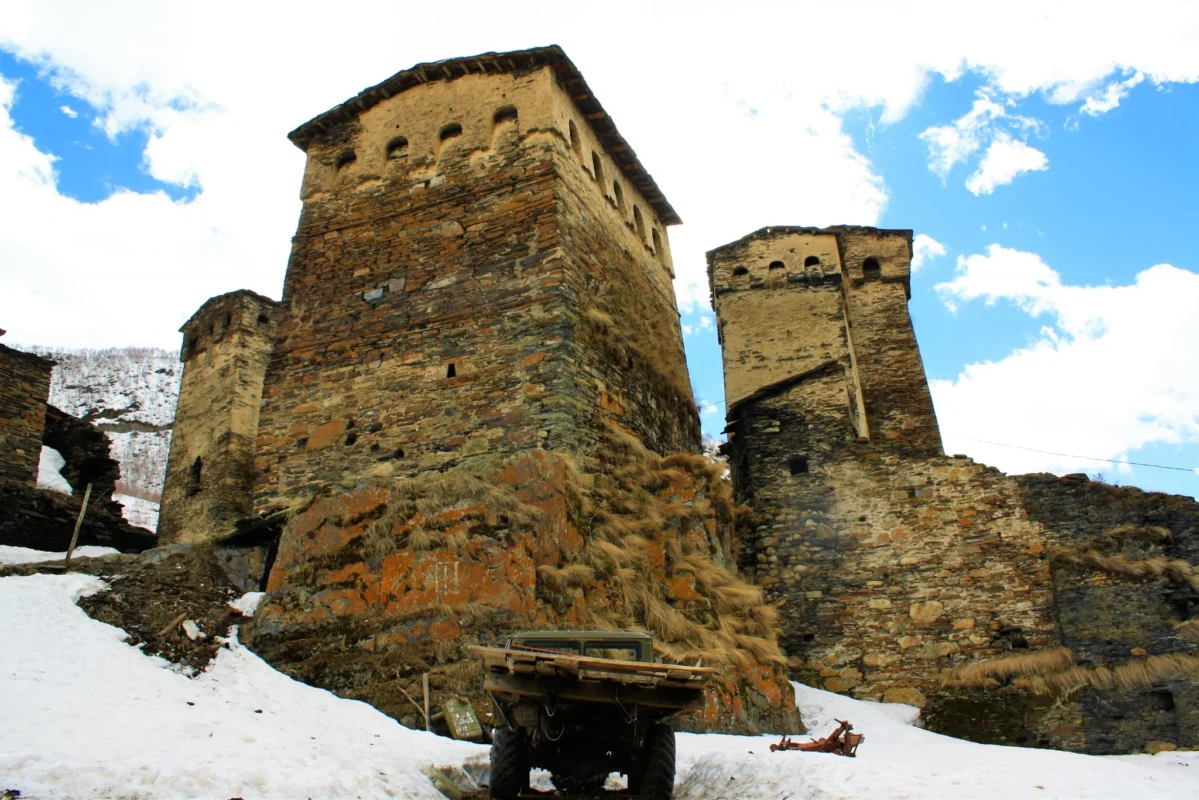
I didn’t actually make it to Ushguili, which is the highest permanently settled village in Europe and a UNESCO World Heritage Site.
Others from the group went on a day trip there from Mestia (journey time around 2 hours each way), but I was still feeling nervous about getting back in the car after our eventful journey to the region!
Those who did drive to Ushguili reported the road to be fine (although there is a risk of avalanches here too) and the village to be beautiful.
If you’re happy to make the trip (please do check with a few locals about the state of the road when you’re in Mestia), buses depart from the Mestia bus station close to the Posta Hotel.
And take a look at my partner’s post about Ushguili for more information (he visited the village back in 2016).
9. Try Svan or Georgian food in the town’s restaurants
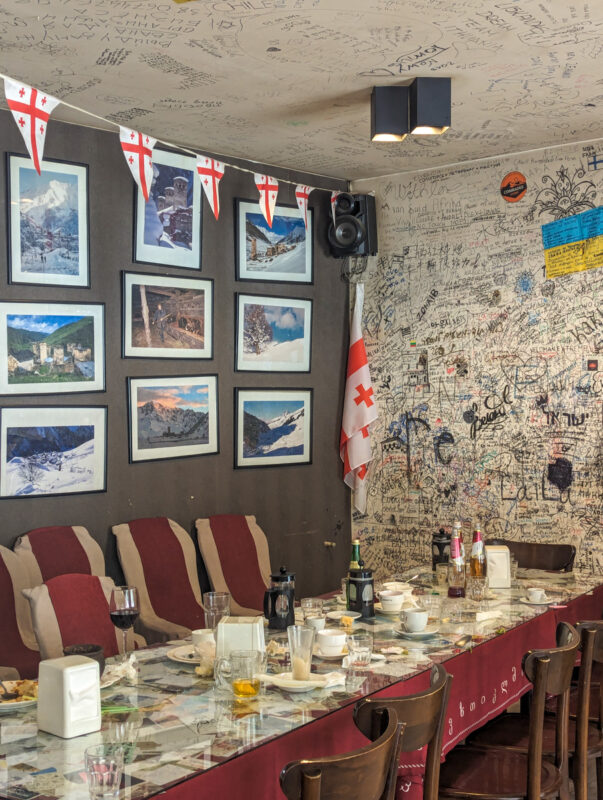
Georgian cuisine is undoubtedly one of the most underrated in the world (check out my TikTok about it!), and there are plenty of spots to sample it in Mestia.
You could also try out some local Svan food, including:
- Kubdari: a stuffed meat pie (like lobiani but with meat)
- Tashmijabi: cheesy mashed potatoes (that taste a bit like polenta)
- Chvishtari: cornbread with cheese
Some of the best restaurants in Svaneti are actually at the hotels. We dined at Hotel Paliani (where we stayed) every night and enjoyed their extensive menu and atmosphere.
Posta and Gistola also offer comprehensive menus.
In town, Cafe Laila serves a diverse menu with lots of salads, bread, meat dishes and veggie options in a graffiti-inspired interior.
10. Stay in town for Lamproba
“One of the most interesting things about Svaneti is the Lamproba festival”, Miriam, the receptionist at my hotel, told me.
Miriam isn’t local and has only lived in the area a few months, and noticed some striking differences between Svan culture to that of her native Tbilisi.
Lamproba isn’t celebrated anywhere else in Georgia. It’s a festival that happens once a year on February 14th (no relation to Valentine’s Day) where locals head to cemeteries to light fires at the feet of their loved ones’ graves.
The idea is that February 14th was often thought to be one of the coldest days of the year, so the lanterns warm their loved ones in the afterlife.
Unfortunatley our trip didn’t coincide with Lamproba, but Miriam told me that there was always a festive feel in the town during this time and it was an interesting way to engage in Svaneti culture.
Things you can’t do in Mestia in winter
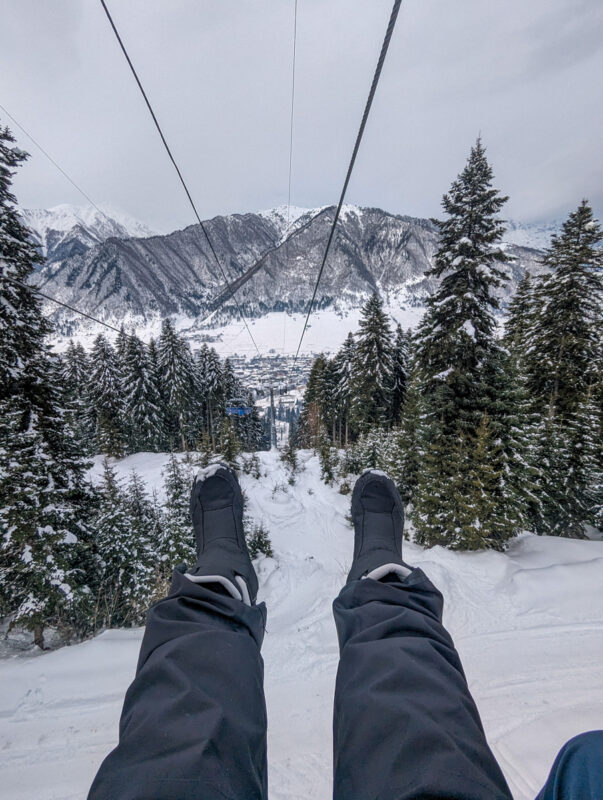
If you’re dreaming of a hiking holiday in the Georgian mountains, winter is not the time to visit Mestia.
The mountains are crisscrossed with hiking trails that, in the summer months, make up some of the best hikes in Europe (or so I’m told!).
However, due to snow and the real risk of avalanches and landslides, these are not accessible in the winter months.
So, if you want to hike in Svaneti, I highly recommend visiting in late Spring (in April there’s still a risk of avalanches), summer or early Autumn/ Fall.
Where to stay in Mestia in winter
For a small town, Mestia has a variety of high-quality hotels, with comfortable rooms, friendly English-speaking staff and plenty of amenities.
Hotel Paliani
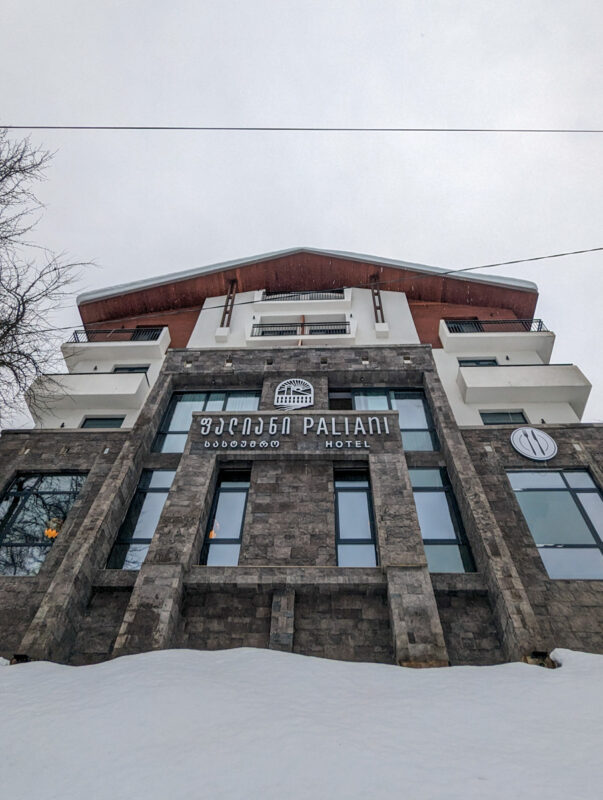
We stayed at Hotel Paliani, a relatively small guesthouse with wonderful views over the town.
Rooms were comfy, contemporary and spacious and the downstairs restaurant served tasty Svan, Georgian and international cuisine.
The staff were friendly and very kind too; Miriam helped me top up my telephone with credit and they organised an early breakfast on our last day.
A few downsides of Paliani Hotel were that it is a bit of a walk from the town centre (around 10-15 minutes without accounting for snow and ice!) and it lacked amenities (other hotels in the town had saunas and indoor swimming pools).
It was also incredibly warm, both in the lobby and in the rooms. We ended up having to sleep with a window wide open, the curtain half covering it and the radiator completely turned off – even though it was sub-zero outside!
However, we were told by other people in our group that all hotels in town seemed to have the same issue.
Also, the WiFi was very poor – but this also seemed to be the case in other hotels in town (apparently this is due to intense Bitcoin mining in the area!).
If you’re looking for somewhere with personable, guesthouse vibes then Paliani was excellent, but if you want somewhere with more facilities Posta may be more suitable.
Check out Hotel Paliani’s listing on Booking.com by clicking here.
Hotel Posta
Hotel Posta is a modern hotel right in the centre of town, and it was where some of our group stayed.
In the lobby, you’ll find a fully stocked bar and the restaurant not only serves a range of Georgian cuisines but also plays traditional music every night!
Everyone who stayed at Posta seemed to enjoy their rooms, and there was also a free-to-use sauna and spa.
If you’re looking for a well-facilitated hotel close to the action, Posta seemed excellent – although it didn’t have quite as local, personable vibes as Paliani.
Check out Hotel Posta’s listing on Booking.com by clicking here.
Gistola Hotel
The other third of our group stayed at the Gistola Hotel. This hotel was situated a bit further out of town than Paliani, although there was a shuttle service that dropped guests off in the centre.
It had similar vibes to Posta – comfortable, with a swimming pool and sauna which we visited to try out (although you had to pay 100 GEL for private use for it for an hour – this could be split amongst up to eight people).
Again, a restaurant here served an abundance of Georgian and international dishes.
However, because of Gistola’s location, I probably wouldn’t advise staying here (unless there’s a significant price difference) and instead choosing between Posta and Paliani, depending on what kind of atmosphere you’re after.
Click here to take a look at Gistola’s listing on Booking.com
Visiting Mestia in December, January, February or March: final thoughts
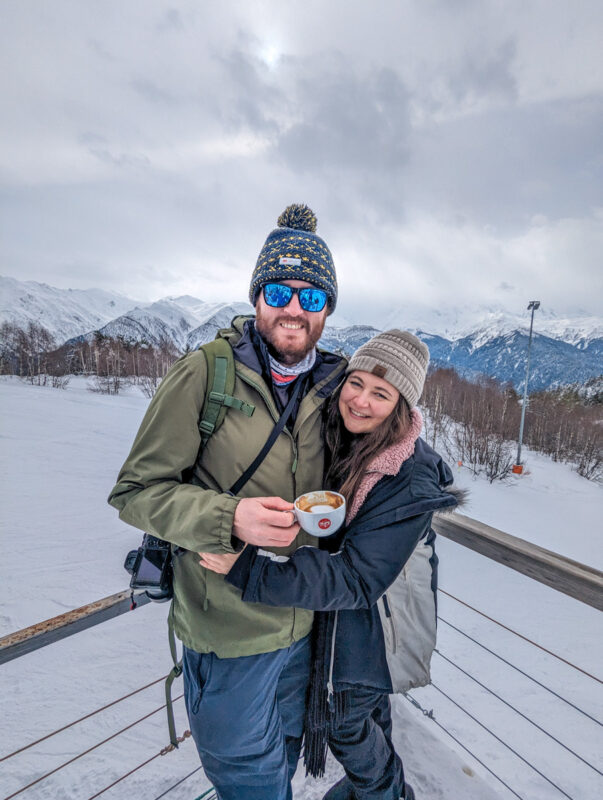
So, should you visit Mestia in the winter? It really depends.
I’d recommend keeping your plans very flexible, leaving lots of time for unexpected delays, and please don’t drive on the Jvari to Mestia road in stormy weather – at best you could end up with long delays and at worst, there is a real risk of danger due to avalanches.
However, with crisp, clear weather, the drive to Mestia from Jvari is nowhere near as nerve-wracking.
And, in Mestia, you’re greeted with plenty of unique things to do, almost deserted ski slopes and a unique culture.
It’s your call whether Mestia in winter is worth the trip!

